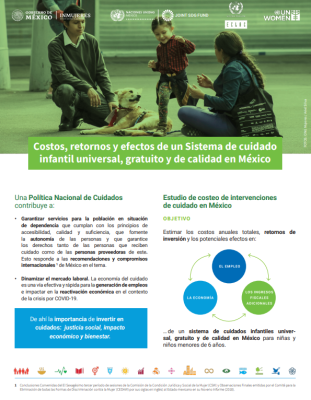Costs, returns and effects of a universal, free, quality child care system in Mexico.
UN Women Mexico, in collaboration with INMUJERES and with support from ECLAC's Subregional Headquarters in Mexico, has developed a series of three studies on the costs and returns of investing in care for children under 6 years of age, for 6 to 12 years of age and for the elderly. Each study is accompanied by a Policy Paper that serves as a tool for decision making.Investment in care policies generates a triple dividend since, in addition to contributing to people's well-being, it enables the direct and indirect creation of quality employment and facilitates the participation of women in the labor force, which means a return of income for the State through taxes and contributions and a higher income for individuals. In the current context of the crisis caused by COVID-19, integrated care systems can become a real driving force for socioeconomic recovery so that no one is left behind.The study was elaborated by constructing various prospective scenarios with a progressivity approach with different levels of coverage, wages and quality of service in the child care system for children under 6 years of age. The configuration of a child care system would have a cost of 1.16% of GDP. However, considering that the current child care system in Mexico has an approximate fiscal cost of 0.45% of GDP in 2019 and that there would be an additional tax revenue of 0.29%, the result is a 5-year average financing gap of 0.58% of GDP. The results point out that the configuration of a child care system is an economically viable and fiscally smart measure.The target audience of this document is decision makers as a tool to build different investment and return scenarios with different parameters to progressively move towards a National Care System. The methodology used in these studies can be replicated in other countries.
- Latin America and the Caribbean





